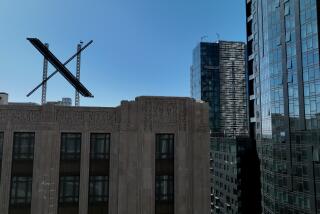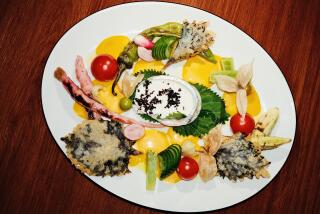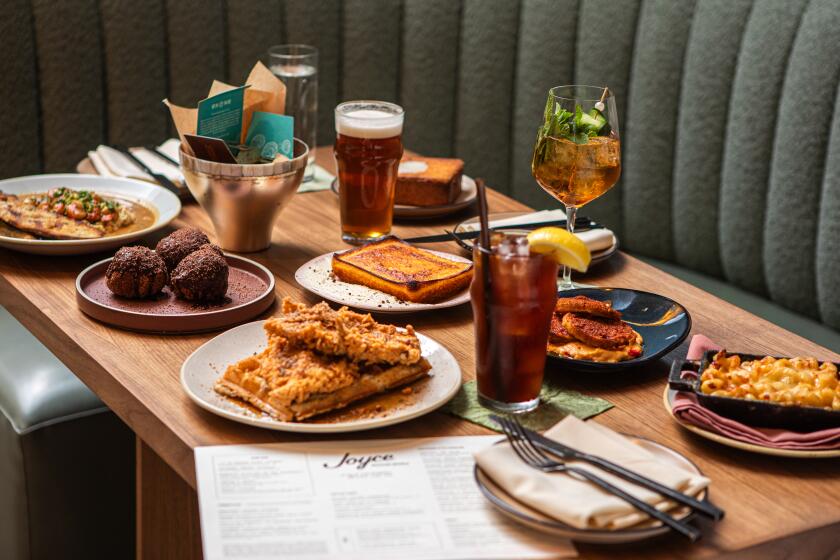Exits, Not Entrees, on the Menu
SAN FRANCISCO — At the Meetinghouse restaurant, they’re meeting no more.
After eight frenzied years, chef-owner Joanna Karlinsky recently made the anguished decision to close the cafe she had dreamed of running, even as a child. On the restaurant’s last night, her regulars tried to muster the good spirits and camaraderie that had defined the eatery since its opening in a converted Victorian house in Pacific Heights in 1996.
Diners offered champagne toasts and bearhugs. To applause, someone crowned Karlinsky with a toy plastic tiara.
For the 40-year-old Culinary Institute graduate, the evening tasted bittersweet. “I’m tired,” she confessed. “I can’t fight all the battles just to keep my doors open. And to tell you the truth, running this restaurant isn’t as much fun as it used to be.”
Karlinsky personifies a distasteful trend that threatens this city’s $5-billion restaurant industry and its reputation as a foodie mecca. Since 2001, San Francisco has lost 7% of its more than 3,000 eateries. In the last two years, 168 more restaurants closed than opened -- 50 shutting down in January and February of this year alone.
“Nothing like this has ever happened here,” said Kent O. Sims, a Bay Area economic consultant who has written two studies for the Golden Gate Restaurant Assn. “Restaurants open and close all the time. But we’ve never had an overall drop like this. People are getting slaughtered.”
Among the latest culinary casualties are some of the city’s most established names. They include Stars, a gathering spot for politicians and high society originally opened by famed chef Jeremiah Tower; the Cypress Club; Brasserie Savoy; the Mission’s eccentric Flying Saucer restaurant; Dine, the trendy South-of-Market dot.com favorite; and even Maye’s Oyster House, a draw for locals and tourists alike since it opened in 1867. Rumors are circulating that one or two nationally noted A-list restaurants could be the next to go.
The restaurant closings are no small deal in a city that considers dining one of its major attractions -- as much as clanking cable cars, crooked streets or signature bridges.
In San Francisco, both residents and tourists spend more time pondering, consuming and then discussing restaurant meals than in any American city outside New York or New Orleans, says Tim Zagat, executive director and co-founder of the popular Zagat Survey Guides.
Sims said San Francisco features more restaurants per capita than any other city nationwide -- a fact made possible by the city’s relatively small population, its tourist-based economy and the daily commuter influx. For six straight years, San Francisco has also been crowned by Bon Appetit magazine readers as America’s fine-dining epicenter.
The dining decline began with the 2000 dot.com fallout and the sudden vanishing act of hungry tech-industry high rollers. In all, the city lost 70,000 jobs; about 50,000 of those were held by commuters who no longer eat out for lunch or grab late-night dinners on the company. For restaurateurs, vacant offices mean empty dining tables.
Then came the Sept. 11 terrorist attacks, a gut punch to the city’s tourist economy. It has yet to recover: In May of this year, 24% fewer travelers passed through San Francisco International Airport than in May 2000.
And this fall, San Franciscans will decide on a proposition to raise the city’s minimum wage by $1.75 to $8.50 an hour, a figure that will not include tips received by those who wait on restaurant tables. Owners say the new wage will push many more eateries to the brink of insolvency.
“Without question, San Francisco has been the hardest hit restaurant community in the entire U.S.,” said Clark Wolf, a New York-based restaurant consultant. “Its demise started before anyone else and has lasted longer.” The reason, he said, is that its success was built around two industries -- high-tech and tourism -- “that have both simply vanished.”
The city’s neighborhood eateries, with low overhead and steady local clientele, remain stable. The most stellar restaurants -- Boulevard, with its haute cuisine; the 150-year-old Tadich Grill in the city’s financial district; and nearby Napa’s French Laundry -- seem virtually depression-proof.
But many mid-sized restaurants are going hungry. Some owners have fired chefs and returned full time to their steamy kitchens. Others have pressed relatives into service and introduced fixed-price menus. Once-bustling cafes now close on slow days and have shorter hours. And upscale eateries are engaging in a last-gasp trade they once would never have dreamed of doing: take-out orders.
Some restaurants have reinvented themselves. In 2000, the Castro district’s JohnFrank restaurant named itself Home and began offering a new line of entrees at half the old prices. “We invented a new concept tailored for the economic times,” said owner John Hurley. “And it worked. Where we once did 50 seatings a night, now we do 400.”
Others continue to feel the pain. Sims said, “Most owners are making less money and working longer hours, just to cover costs. For many people, this is a make or break year.”
Success Meant Pressure
Quinn McKenna recalls the good times when tables were always full at his One Market restaurant along the picturesque Embarcadero. Frequently, a waiting line stretched around the corner.
The eatery, featuring California cuisine, was among the city’s hottest new chef-driven, spare-no-expense A-list restaurants. But with success came pressure. McKenna, vice president of operations for the company that runs One Market, said: “Every person I met would say ‘Quinn, can’t you please squeeze me in? Can you just find a spot for me?’ ”
One night during the high-tech bubble, when the entire restaurant was booked, the owner of a start-up paid $10,000, just to rent the restaurant’s bar area to throw a party for his employees.
That first year, in 1993, the 150-seat restaurant did an astounding $8 million in sales. Eventually, though, the city’s dot.com economy imploded and thousands of jobs disappeared. The layoffs, which began in 2000, changed the way San Francisco dined out.
Gone were $2,500 expense account dinners and midnight seatings for 12. Vintage bottles of Cabernet costing $500 stayed corked. And those lines that snaked outside many restaurants? Also a thing of the past.
One Market owners changed the menu and cut prices. “In this climate,” McKenna said, “you’re not making lots of money -- you’re struggling to still be there next month. There are few restaurants in town that don’t share that fear.”
The Golden Gate Restaurant Assn. funded two studies to define the industry’s economic fallout. For executive director Patricia Breslin, the answers were enough to give her indigestion.
From 2001 to 2002, median table service restaurant income dropped 40%; restaurant advertising fell 70%; and the number of applicants seeking restaurant work rose 50%.
Breslin laments that many restaurant owners are now skipping San Francisco to open venues in cities such as Las Vegas, where the service economy is less of a roll of the dice.
“One owner told me that, just three years ago, they were opening new venues and were feeling strong, like they were swinging from a great big rope,” Breslin said. “Now that rope is a very fine thread and they’re wondering what issue will be the pair of scissors that cuts it off.”
For finicky diners, this may not be bad news.
“San Francisco was too bloated with restaurants -- every new high-tech millionaire opened a restaurant they claimed was the next best thing in local ingredients,” said Tanya Steel, the New York editor of Bon Appetit. “But many came with mediocre service and inexperienced kitchens that were not ready for the hordes.
“Now it’s survival of the fittest -- and that’s good for diners.”
Some diners aren’t so sure. “Losing restaurants like this one can’t be good,” said George Burwasser, a San Francisco geologist and former Meetinghouse regular. “This place had everything -- good food, great service. And it still didn’t make it.”
Focus on Feeding People
Joanna Karlinsky calls herself a “big-mouthed troop leader” who loves to feed people. “I love to keep people happy,” she said. “I like to throw parties, but I really don’t like to go to them.”
Karlinsky got serious about feeding people in 1996 when, along with boyfriend John Snell, she opened the Meetinghouse, using savings and a loan from her father.
Karlinsky served good old Americana -- warm homemade biscuits, mounds of mashed potatoes and double-cut pork chops. A reviewer described the Meetinghouse as “one of those tiny spots that beckons you as you drive by on a foggy night, making you wish you were there among the diners seated at the twinkling tables ... one that might inspire you to want to open a restaurant of your own.”
But actually running the place eventually dimmed the romance. The tireless Karlinsky was everywhere -- talking up regulars, taking over her staff’s shifts, scrubbing toilets, even playing valet in a pinch.
For several years business thrived. From her $150,000 prep kitchen, Karlinsky opened a catering and commissary business with 50 employees. Yet slowly her labor of love became just plain labor. Karlinsky and Snell began to quarrel and finally broke up before he eventually left the business.
The two had always believed in paying workers a living wage that included full health insurance and annual raises. As a result, entrees weren’t cheap -- ranging from $25 to $31. But Karlinsky wasn’t getting rich. Most years, she took only $44,000 herself from the cafe’s $1.5-million annual income. Among other expenses, she paid $500,000 in wages, $35,000 for laundry and cleaning supplies, $31,000 for valet parking. She ended up dumping money from her other ventures into the restaurant.
Still, Karlinsky laid off staff members and took on more tasks herself. Meanwhile, she was diagnosed with high blood pressure from working 90 hours a week. Then she severely burned her hand in a kitchen mishap. “Here I am, running five businesses grossing over $3.5 million a year, and I have to call my mom for a loan?” she said. “I didn’t even make enough profit to cover my mortgage.”
She said she will never forget the highs -- trips to the farmers market for fresh vegetables, the rush of being paid to cook for others. But Karlinsky can’t shake the feeling that San Francisco let her down, that, unlike New Yorkers after 9/11, her customers didn’t try hard enough to see their favorite restaurant through the hard times.
So she fired a parting shot. On the window of her now-defunct Meetinghouse remains a green-inked message: “Thanks for your patronage. Now get used to bad service wherever else you go.”
More to Read
Eat your way across L.A.
Get our weekly Tasting Notes newsletter for reviews, news and more.
You may occasionally receive promotional content from the Los Angeles Times.











